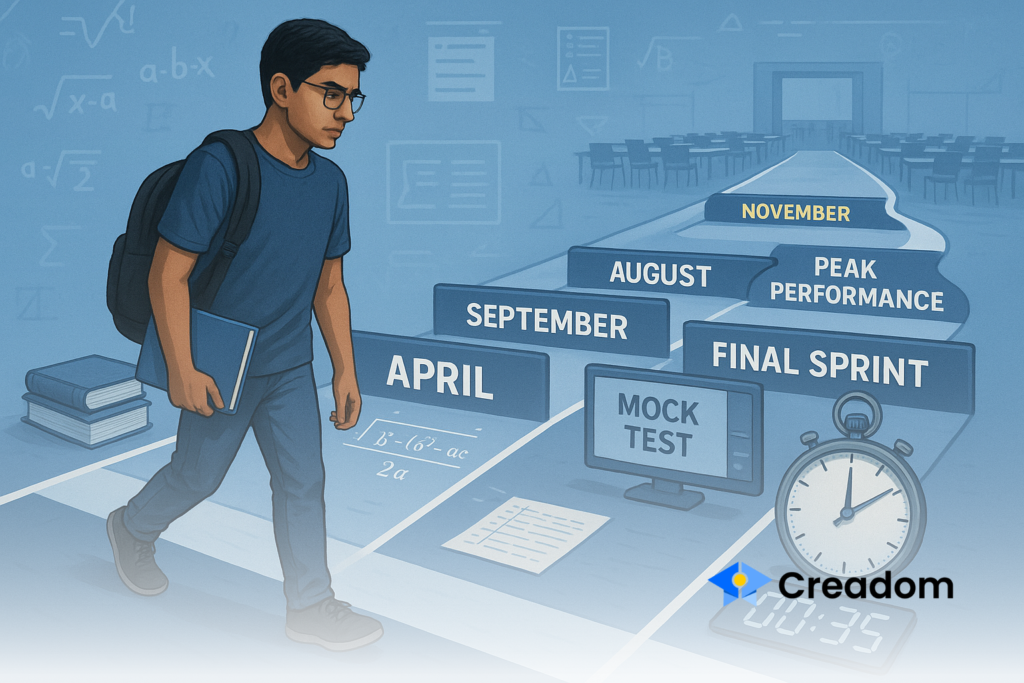
How to Crack CAT in 5 Months: A Strategic July to November Preparation Roadmap
Cracking CAT in 5 months is difficult—but absolutely doable with clarity, structured plan, and commitment. Whether you’re just beginning in July or restarting after a break, this roadmap will guide you through a month-wise preparation plan that focuses on building concepts, practicing efficiently, and testing strategically.
This isn’t a motivational pep talk or a generic “study harder” guide. It’s a professional plan designed to help aspirants who are serious about cracking CAT in November.
Know Where You’re Starting From
Your preparation strategy must be based on your current academic and aptitude level. Just like fitness goals depend on current weight, stamina, and routine—CAT prep depends on your:
- Conceptual understanding in Quant and LR
- Familiarity with reading comprehension
- Mental stamina for timed problem-solving
A beginner will need more time on basics; a repeater might focus more on testing and revision. Don’t blindly follow someone else’s timetable; customize your plan based on your:
- Strengths and weaknesses in each section
- Available study hours per day
- Work or college schedule
What You Need to Begin
While the CAT exam doesn’t come with an officially published syllabus, years of pattern analysis and question trends allow us to identify the core areas you must master. CAT tests a wide range of skills—but it consistently revolves around three key sections:
- Quantitative Aptitude (QA)
- Data Interpretation & Logical Reasoning (DILR)
- Verbal Ability & Reading Comprehension (VARC)
Each of these sections contains specific topics that appear frequently, and knowing what to expect can dramatically streamline your preparation. More importantly, beyond just knowing what to study, there are certain foundational elements—like squares, cubes, and fraction-to-percent conversions—that aren’t just helpful, they’re non-negotiable. These basics drastically improve your calculation speed, mental approximation, and overall efficiency across sections.
Let’s break down the syllabus, starting with each section and closing with the critical foundations every serious CAT aspirant must commit to memory.
Core Syllabus Breakdown
While CAT doesn’t publish a fixed syllabus, here’s a reliable breakdown:
Quantitative Aptitude (QA)
- Arithmetic
- Algebra
- Number Systems
- Geometry
- Modern Math
Data Interpretation & Logical Reasoning (DILR)
- Arithmetic-based DI
- Reasoning-based DI
- Arrangements
- Scheduling
- Venn Diagrams
- Routes & Networks
- Games and Tournaments
- Miscellaneous sets
Verbal Ability & Reading Comprehension (VARC)
- Reading Comprehension (RC)
- Parajumbles
- Parasummary
- Odd Sentence Out
- Para Completion
Non-Negotiable Foundations
- Squares: 1 to 50
- Cubes: 1 to 30
- Fractions: 1 to 30
- Common square and cube roots
These are not optional. They significantly improve speed and approximation accuracy, especially in DILR and QA.
The Right Tools to Study
In today’s world of abundant content, one of the biggest challenges isn’t a lack of study material—it’s having too much of it. From paid online courses to free YouTube videos, test series to practice books, the options can feel endless. But here’s the truth: collecting resources is not the same as preparing effectively. The real game-changer is choosing one reliable path—and committing to it fully. Whether you’re studying Quant, DILR, or VARC, the goal is to build depth, not just breadth. In this section, we’ll help you identify which resources are worth your time and how to use them wisely, so you can focus your energy where it matters most.
Learning Tools
Use either:
- Paid online courses (from credible institutions)
- Free YouTube content (Rodha, Career Launcher, Elites Grid for DILR & QA and Gejo Speaks for VARC)
The key is not to collect resources endlessly—choose one and commit to it.
Practice Tools
- Previous year CAT questions (segregated by topic/year). You can read our previous blog on how previous year CAT questions can help you score more marks.
- Sectional tests (from test series or books)
Testing Tools
- Choose one test series only: CL or IMS. The reason why should choose either CL or IMS is because it is ensured that large student participation takes place and the mock is closely aligned with CAT format
- Avoid relying on free or random mock tests, as they often lack reliability, feature poorly structured questions, and fail to accurately reflect the CAT pattern—ultimately doing more harm than good to your preparation.
The Importance of Community and Mentorship
Preparing alone can lead to burnout, inconsistency, and unaddressed doubts. Joining a peer group (Telegram, WhatsApp, or coaching forums) offers:
- Daily motivation and accountability
- Faster doubt resolution
- Shared resources and strategies
If you’re stuck despite following the plan, personalized mentorship can help:
- Identify blind spots in your approach
- Customize the plan based on your specific challenges
- Provide ongoing support and feedback
You can join my Telegram group MBA Career Freedom for free peer support. For one-on-one mentoring, you can book a personal call with me via Topmate.
Month-by-Month Strategy: July to November
July: Build Strong Foundations
This is the month to learn concepts.
Focus Areas
- QA: Only Arithmetic and Algebra
- DILR: Basic set familiarity and mental stamina
- VARC: Reading Comprehension + 5-6 verbal questions per day
Daily Schedule (If You Have 4+ Hours)
- 2 hours: QA (15 questions/day)
- 2 hours: DILR (3 sets)
- 2 hours: VARC (2 RCs + verbal exercises)
If You Have Less Time
- Daily: Your weakest section + one rotating section
- Example: If VARC is weak, do VARC daily, and alternate between QA and DILR
Weekends
- Saturday: Full mock test
- Sunday: 6-hour in-depth mock analysis
- Focus on learning what you didn’t do well
August: Concept Completion + Time Discipline
Begin practicing in a time-bound manner.
QA Sequence
- Numbers
- Geometry
- Modern Math
DILR & VARC
- Continue regular practice
- Focus on accuracy and consistency
Introduce Sectional Tests
- At least 1–2 sectional tests per week
- Begin applying time pressure (e.g., 40 minutes for a DILR section)
Use timers even when solving from books. Time-bound problem-solving is now non-negotiable.
September: Mock-Based Preparation
Shift your approach entirely to mock-centric learning.
Weekly Routine
- 2 full mocks/week
- 2–3 days of analysis and topic revision from weak areas
- Practice more on areas you’re already strong in—to improve speed
Why It Works
- You identify patterns of errors
- Your stamina improves
- You sharpen your test-taking strategy
By the end of September, you must be excellent in at least one section—QA, DILR, or VARC—to carry your overall percentile.
October: Push to Peak
- 1 mock every alternate day
- Deep mock analysis the following day
- Revise formulas, concepts, and notes—not relearning, just reviewing
If analysis takes longer, stretch it across two days. Quality matters more than speed here.
November: Final Simulation
- Maintain alternate-day mocks
- Mimic test conditions
- Shift your schedule to match CAT timings
- Focus entirely on analysis and minor refinements
- Avoid new content unless it’s from recent mocks
Final Advice: Customize, Don’t Copy-Paste
No rigid day-wise Excel sheet can predict life’s uncertainties. Plans must allow for flexibility. If your job is intense or study hours fluctuate, adjust accordingly. The core idea is to move from conceptual learning → time-bound practice → test strategy, in a phased and focused manner.
If you want personal guidance or help adjusting the strategy to your schedule, reach out via the links shared in the blog.
This is your complete roadmap—from knowing nothing in July to potentially securing an IIM call by November. Stay committed, practice wisely, and always, always analyze what’s working and what’s not.
Good luck and stay focused.

Your Authors
Along with Darpan Saxena, this article has been co-authored by Om Kasarkhedkar.
Om is a marketing enthusiast with strong leadership skills, creativity and a knack for helping students with their CAT preparation. As an aspirant himself, he had received interview calls from the prestigious MDI Gurgaon and MICA, Ahmedabad.
 Get access to such unique MBA career insights
Get access to such unique MBA career insights



